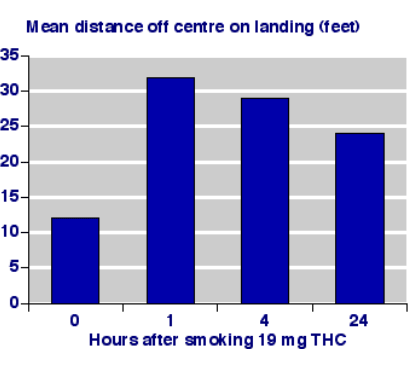Last updated : April 21, 2025
As states have moved toward legalizing marijuana, the question has been raised about driving under the influence. With alcohol, a police officer can perform a simple test to determine how much alcohol is in the person’s system. Blood alcohol level is generally a very good indicator of impairment. With marijuana, the level of THC (the ingredient in marijuana that causes the high) in the blood does not seem to correlate as closely to impairment.
The first thing to realize is that DUI laws still apply to marijuana.
If you are high when you are pulled over and you fail the DUI test that the officer requires (following a pen with your eyes, walking in a straight line and standing on one foot), then you will be charged with Driving Under the Influence.
Two different studies estimated independently that driving under the influence of marijuana increased the chances of accidents by a factor of two. Drivers under the influence are twice as likely to have a accident.
The states that have legalized recreational use of marijuana (Colorado and Washington) have both established the limit for driving at five nanograms of THC per milliliter of blood. Studies from Europe suggest that that limit is too high. In Sweden, 90% of drivers under the influence of marijuana were below the 5ng/mL level. The limit would need to be lower to catch them.
Some experts recommend setting the limit at 1ng/mL. One of the challenges of using THC blood levels is that THC deposits in fat cells and is released over time. That is one of the reasons a urine drug test may be positive days after the user ingested the drug. Regular drug users (and those using marijuana for medicinal purposes) complain that even when they are not high, they will have at least 1 ng/mL (or even 5 ng/mL) in their system.
A compilation of four clinical studies of the effects of marijuana on airplane pilots showed the impairment long after the high wore off. The studies compared the abilities of pilots who smoked pot to pilots who smoked a placebo (something that did not make them high). All four studies found that marijuana reduced the pot smoking pilots’ ability to fly an airplane. Actually, they put them in flight simulators, not real airplanes.
I think most pot smokers would agree that, in general, they do not operate equipment or make decisions affecting people’s lives when they are high. That’s where the rest the studies come in.
Even hours or days after smoking, the pot-smoking pilots still performed worse. Let me ask you, by how many feet would you like for your pilot to miss the center of the runway?
In the graph below, you can see the impact of the pot. Even 24 hours after smoking, the pot-smokers margin of error was twice as large as the non-smokers.

Forty-eight hours later—that’s right, two days—there was still a noticeable difference in performance.
It doesn’t seem fair that even after the high is over, a pot smoker’s performance is still impaired. But those are the proven facts.